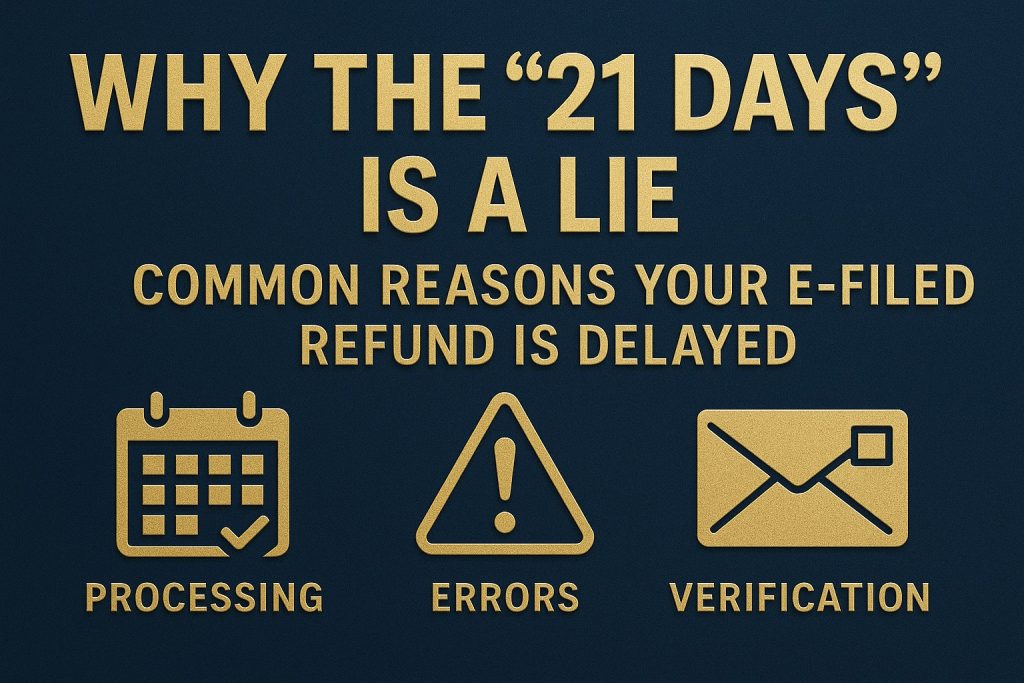Everyone hears it every tax season: “If you e-file your tax return, you’ll get your refund in 21 days.” Sounds simple, right? But the truth is, the “21-day refund” promise is often more of a hopeful guideline than a guarantee. In reality, many taxpayers experience frustrating delays well beyond that timeframe—and knowing why can help you avoid unnecessary stress.

Here’s a clear, easy-to-understand breakdown of the most common reasons your IRS e-filed refund might be delayed.
1. The “21 Days” Starts Only After IRS Acceptance
First, the 21-day clock begins tickingonly after your return is accepted by the IRS—not from the day you hit submit. Acceptance usually takes 24 to 48 hours but can be longer during peak filing season.
2. PATH Act Holds on EITC and Child Tax Credits
If your return claims theEarned Income Tax Credit (EITC)or theAdditional Child Tax Credit (ACTC), your refund cannot be released beforeFebruary 15due to the PATH Act—a federal law designed to reduce fraud. Even if you file in January, you won’t receive the refund for these credits until mid-February or later.
3. Identity Verification Requests and Fraud Prevention
The IRS aggressively screens for identity theft and may send you averification letter (such as Letter 5071C)asking you to confirm your identity. Until you verify, your refund is delayed. This step protects your money from fraud but adds weeks to your wait.
4. Errors or Missing Information on Your Tax Return
Simple mistakes—incorrect Social Security numbers, filing status errors, or skipped forms—can slow IRS processing. The IRS may need to manually review or contact you, which delays refund approval.
5. Amendments, Extensions, and Special Claims
Filing amended returns, requesting injured spouse allocation, or using an Individual Taxpayer Identification Number (ITIN) often triggers longer processing times—often several weeks or months.
6. IRS Backlogs and Operational Delays
The IRS workforce and resources fluctuate yearly. During peak times or budget constraints, the IRS may face backlogs causing all refunds—even straightforward ones—to slow down.
7. Offset for Past-Due Debts
If you owe debts like child support, federal or state tax bills, or student loans, your refund may beoffsetby those amounts. This means you’ll get less than expected, and the offset process can delay your refund posting.
What Can You Do?
- File Early:Submit your return as soon as you have all documents.
- E-file and Choose Direct Deposit:This combination is the fastest way to get refunds.
- Check the IRS “Where’s My Refund?” Tool:It updates once daily and reflects latest IRS status.
- Respond Promptly to IRS Notices:Don’t delay if asked to verify identity or provide documents.
- Avoid Multiple Filings:Don’t file duplicate returns; it only slows down processing.
Final Thoughts
The promise of a 21-day refund is a helpful benchmark but not a sure thing. Multiple factors—fraud prevention laws, identity verification, errors, credit claims, IRS workload, and debts—can stretch refund times well beyond three weeks.
Understanding these realities will help you set realistic expectations, manage your tax season with less stress, and take sensible steps to get your refund as quickly as possible.
By staying informed and proactive, you can navigate tax refund delays with confidence—turning waiting into winning.
